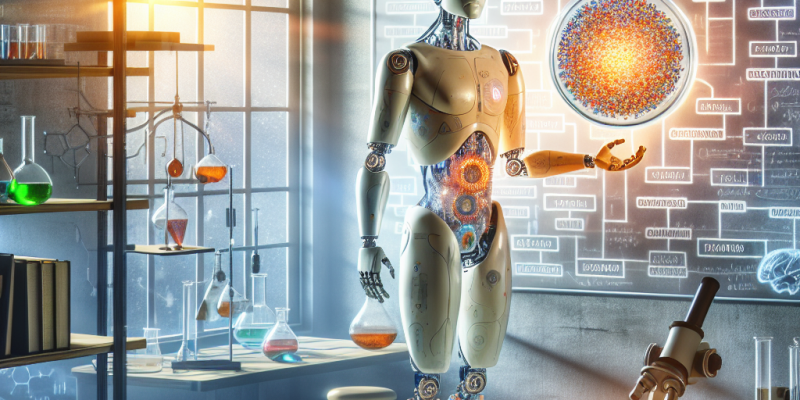The Role of Generative AI in Scientific Research and Discovery

In recent years, generative artificial intelligence (AI) has emerged as a transformative force across various sectors, from art to business. Its application in scientific research and discovery, however, is particularly profound, revolutionizing traditional methodologies and facilitating unprecedented advancements. This article explores the multifaceted roles of generative AI in the scientific landscape, examining its applications, benefits, challenges, and future potential.
Understanding Generative AI
Generative AI refers to a category of artificial intelligence that can create new content, data, or artifacts based on the input it receives. Unlike traditional AI, which primarily analyzes and interprets existing data, generative AI uses algorithms, such as Generative Adversarial Networks (GANs) and transformer models, to generate original outputs. This capability has found applications across a range of disciplines, including natural language processing, image generation, and even molecular design.
Applications in Scientific Research
1. Drug Discovery
One of the most compelling applications of generative AI is in drug discovery. Traditional methods often involve lengthy and costly laboratory processes. AI models can rapidly generate molecular structures and predict their potential effectiveness against specific targets. For example, researchers at Insilico Medicine employed generative models to design new compounds, significantly speeding up the identification of viable drug candidates. Such advancements can considerably shorten the timeline for drug development, ultimately benefiting patients in need of new treatments.
2. Material Science
Generative AI is also revolutionizing the field of material science. By simulating and generating novel materials, AI can help scientists discover new compounds with unique properties. Researchers can input specific properties into generative models, which then output potential material structures that meet those criteria. This approach not only accelerates discovery but also opens up avenues for creating materials that would be infeasible to identify through traditional experimentation.
3. Climate Modeling
In the realm of environmental science, generative AI can enhance climate modeling efforts. AI can generate synthetic datasets that simulate various climate scenarios, helping scientists to predict potential outcomes with greater accuracy and confidence. This capability is particularly vital in addressing climate change challenges, as it enables researchers to better understand the interactions between various environmental factors and formulate effective strategies for mitigation.
4. Biomedical Research
Generative AI has applications in genomics and personalized medicine as well. By analyzing large datasets from genetic research, AI can generate hypotheses regarding gene functions and interactions. This not only aids in understanding complex biological systems but also enhances the potential for developing tailored therapies based on individual genetic profiles.
Benefits of Generative AI in Science
- Speed and Efficiency: Generative AI can process vast amounts of data and generate insights at an unprecedented pace, making the research process more efficient.
- Cost-Effectiveness: By streamlining the discovery phases, generative AI has the potential to reduce the costs associated with research and development.
- Novel Insights: AI can identify patterns and relationships that may not be immediately evident to human researchers, leading to new hypotheses and research directions.
- Interdisciplinary Collaboration: Generative AI facilitates collaboration across different fields, combining expertise from biology, chemistry, data science, and engineering to foster innovative approaches to complex problems.
Challenges and Considerations
While the benefits are substantial, the integration of generative AI in scientific research also comes with challenges:
- Data Quality: The effectiveness of AI models heavily relies on the quality and diversity of the input data. Poor or biased data can lead to inaccurate results and hinder scientific progress.
- Interpretability: Many generative AI models operate as “black boxes,” making it challenging for researchers to understand how certain outputs were derived. This lack of transparency can raise concerns regarding the validity and reliability of AI-generated findings.
- Ethical Concerns: The use of AI in research can lead to ethical dilemmas, especially when it comes to issues of consent in biomedical applications and the potential for misuse of AI-generated information.
The Future of Generative AI in Science
As technology advances, the potential of generative AI in scientific research is likely to expand even further. Ongoing improvements in algorithms, coupled with the increasing availability of high-quality data, will enhance the capabilities of generative models. Furthermore, a greater emphasis on ethical AI frameworks will be crucial to ensuring that the benefits of this technology are realized responsibly.
Conclusion
Generative AI represents a transformative force in scientific research and discovery, breaking down traditional barriers and paving the way for innovative solutions to complex challenges. As researchers increasingly embrace this technology, the future promises to unlock new dimensions in our understanding of the world, fostering advancements that could have profound implications for science and society alike. The journey has just begun, and its potential remains largely untapped.














